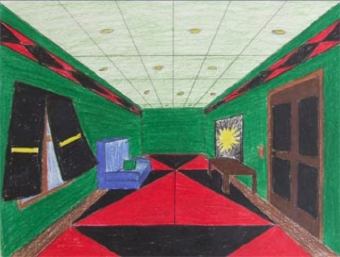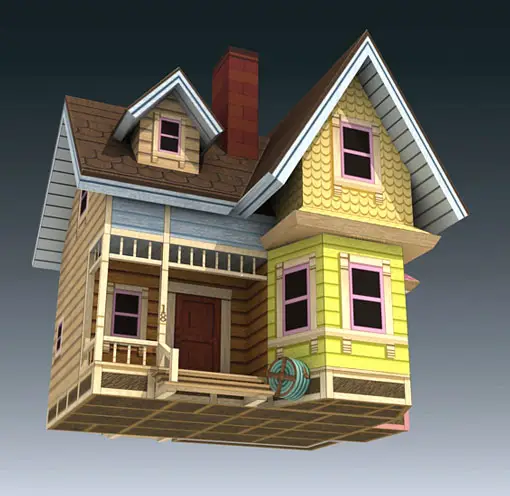How to Draw Parallel Lines as They Approach Vanishing Point
1, 2, and 3-Point Perspective
Submitted by: Barbara Rhodes, retired art teacher
Title: 1 Point Perspective
Unit: Beginning Art Perspective
People across the world seem to have a difficult time grasping the concept of perspective drawing. Hopefully these lessons will help people understand one, two, and three point perspective. Although these lesson are at the high school level, most students still have a difficult time grasping the concept. Because of this, a more difficult one-point perspective lesson is presented first.
Any perspective lesson should cover famous art that centers around sound perspective. Links to art by M.C. Escher, Brunelleschi, and Piero della Francesca are below. Francesca uses linear one-point perspective to center the attention to a baptistery door in his painting called, "View of an Ideal City."
 Florentine sculptor and architect, Fillipo Brunelleschi, was the first architect to use mathematical perspective when designing buildings during the early Renaissance. Before this time, artists guessed where the lines of buildings would go in their drawings. These drawings tended to look skewed and awkward.
Florentine sculptor and architect, Fillipo Brunelleschi, was the first architect to use mathematical perspective when designing buildings during the early Renaissance. Before this time, artists guessed where the lines of buildings would go in their drawings. These drawings tended to look skewed and awkward.
Vocabulary
Horizon line: Where the sky meets the ground, a horizontal line.
Vanishing point: The place where all lines meet or "vanish," it is located on the horizon line
Perspective: a point of view involving space (POA); to show distance/depth.
Horizontal line: A line that goes left to right, it is parallel to the horizon line
Vertical line: a line that goes up and down, it is perpendicular to the horizon line
Orthogonal line: lines that create the sides of an object in one point perspective, these lines are drawn to the vanishing point.
Diagonal line: Lines that have a slanted direction.
Perpendicular line: Lines that intersect or form right angles (90 degrees)
Intersecting line: Lines cut or divide by passing through or across
Parallel line: Lines that are in the same plane but never meet (intersect) no matter how far extended.
One Point Perspective
Procedure:
1) On 12 x 18 [30.5 x 45.7 cm] white Drawing Paper, students take a ruler or yardstick and draw a straight line from one corner to the opposite corner. Make sure you make your lines light enough so they erase easily. They will do this to all four corners. Students then measure from the center where the lines cross outward about 3" [7.6 cm] and make a small mark. The distance from the center may vary from student to student depending on what they will add to their pictures. After doing this to all four lines, students then draw parallel line horizontally from each mark. They will also make two perpendicular lines from the same marks (See image below).

2 ) Students will add additional lines from the center point that will become the tops and bottoms of chairs, doors, windows, etc. The student will choose a specific decor such as a hallway interior, bedroom, or school room. The teacher can focus on a specific medium or let the student decide what to use. As an extension, students may imitate a famous artists style or subject matter.
Examples below are done in both pencil and colored pencil. Click on the images for full size.






Materials
Drawing Paper
Colored Pencils or Prismacolor Colored Pencils
Drawing Pencils
Magic Rub Erasers
Rulers
Perspective Drawing PowerPoint
Introduction to Perspective PowerPoint
Two Point Perspective PowerPoint
Three Point Perspective Amazing Maze PowerPoint
Two Point Perspective
Two point perspective is slightly more difficult because you are drawing objects with a second angle. Instead of just one vanishing point, you now have two. Usually each point is on the far left and far right of the paper. You should use two-point perspective when you are looking at an object at an angle that is not head-on. In the drawing below you see the beginning of the foundation of a building or a maze.

When your lines go below the horizon line, the object will either appear to be below you or show up as you would see it from your own vantage point. If the object is too tall, you would need a third point for your perspective drawing. A possible introduction to prepare students for the 2-point perspective would be for them to create a maze from above. The maze should have some height, but not enough so you can't see inside. The above illustration shows how you would start such a maze. You can use this same subject for a three point perspective project (See bottom).
Procedure
Following your maze introduction project (listed above) students are now ready to draw a creative 2-point perspective drawing. One such project would be a 2-point perspective viewed from below. Students would be creating floating structures. The movie, Up, is a great movie to be a lead-in to the lesson (See materials below). In this movie, there is a floating house that illustrates perfectly the effect you are looking for. You don't need to show the entire movie, just the part showing the house floating in the air.
1) Near the bottom of the page, use a ruler to create a horizon line. On each end of the line, create a vanishing point. Make sure all your lines are light enough to easily erase. Make a vertical line on the page where you want the front corner of the house to be. Draw a line to each vanishing point from the top and bottom of this line. The line MUST be above the horizon line. You can now use two more vertical lines to create length and depth for your home. If you want a longer home, then the front side will have the vertical lines farther apart. From the bottom of these new lines, have them go to the same vanishing points. An easy way to remember this process is to use the four "C's," Corner, Connect, Cut-off, and Cross over. (See illustration below)

2) You can now add more details. Like the "Up" house below, there is an extension for the roof, a porch, a chimney, and wood or vinyl siding. All of these details will follow the same rules for 2-point perspective. More advanced students can take on more details. They may also add additional buildings such as a garage or neighbor's home if time allows.

3) Erase any lines that aren't part of the house such as lines that continue on to the vanishing points. Students can now add color to their drawings. Students will use colored pencils to add the color. Prismacolors provide a richer color but are usually more expensive. Remind students to add shadows and consider where their light source is. As in the picture above, students should add some detail to the bottom of the house and not have simply one color. The picture shows floor joists.
NOTE: The above illustration is actually using 3-point perspective but the third angle is barely visible and will fit 2-point nicely.
Materials
Up movie by Disney/Pixar
Drawing Pencils
Charcoal Pencils, Prang Colored Pencils
, or Prismacolor Colored Pencils
Sulphite Drawing Paper
Magic Rub Erasers or Artgum Erasers
Rulers
Three Point Perspective
Usually, a third point is used in perspective when there are extreme heights (or depth) such as skyscrapers. When viewing skyscrapers from the sidewalks below, the buildings appear to get smaller as they rise. The edges of the building will not only recede to the two vanishing points from a corner, there will be an upward (or downward if you are flying over the buildings and creating a bird's eye view) recession to a vanishing point.
M.C. Escher uses three-point perspective in the link at the bottom called, Ascending and Descending . In this picture, all the convergence lines recede to vanishing points at the left, right and on the bottom. Even though this is similar to a two-point perspective exterior, he is using the third vanishing point to allow the viewer to perceive the vertical depth. This bird's eye view allows one to see planes receding back in three directions.
Procedure
This is an introduction to three point perspective and not intended to be for advanced students. Students are drawing a chair in the art room (or whatever room your youth is in) in three dimensions.
1) Find a chair in the room and stand about four or five feet away from it (1.2 - 1.5 meters). Look down on it and draw a quick sketch on small paper of the chair as you see it. At this point it is possible students will not sketch it correctly because of the angle. Bring the sketch back to your work space and draw a horizon line near the top of the page. Mark a vanishing point on both ends of the horizon line. Mark a third vanishing point at the bottom of the paper centered over the place you want your chair to appear.

2) Using their quick sketch as a guide, they will now draw lines from each vanishing point. If the vanishing points are all on the paper, the chair will appear distorted and exaggerated. To overcome this, the student can mark the vanishing points off the picture plane of the paper (See illustration above) and use a tack and string to mark the lines. They may also use a yard stick to follow the lines from the vanishing points to the picture plane.
3) Once the drawing is completed, details and color may be added as time allows.
Alternate: Students can use the maze listed in the two point perspective project and add a third dimension to make a three-point perspective maze. Students will add watercolors when finished. See student samples below. Click on the images for full size:



Resources
Lesson Links
One Point Perspective - by Harold Olejarz
Bunki Kramer's lesson
Perspective Drawing by Andy DiConti
How to Draw a House in Two Point Perspective
Linear Perspective by Michael Delahunt
DeChirico Inspired Perspective lesson by Stephanie Royko
Perspective in Art Links
View and Perspective of the Hotel de Mars (One point perspective) by Gabriel Perelle.
The Nave of the Church by Filippo Brunelleschi
Old Sacristy by Filippo Brunelleschi
Tower of Babel - Three Point Perspective by M.C. Escher
Escher Mezzotint, 1946
Ascend & Descend by Escher
Perspective view of the Chateau, 1668 by Pierre Patel
Books
Perspective Made Easy - Few artists know the simple rules that make perspective in art. Now they can remedy that situation with this step-by-step book, the first devoted entirely to clarifying the laws of perspective. Using over 250 simple line drawings, the author leads the reader through every important concept.
Perspective Without Pain - Simple instructions and hands-on exercises to teach you how to create a sense of depth in your drawings and paintings. Now go a step further—imagine having fun with perspective. With this book, you will. Here Phil Metzger give you clear-cut guidelines in everyday terms—with a lot of friendliness and a little humor tossed in along the way.
The Magic Mirror of M.C. Escher - Long before the first computer-generated 3-D images were thrilling the public, Escher was a master of the third dimension. His lithograph "Magic Mirror" dates as far back as 1946. In taking that title for this book, mathematician Bruno Ernst is stressing the magic spell Escher's work invariably casts on those who see it.
How to Draw Parallel Lines as They Approach Vanishing Point
Source: https://www.incredibleart.org/lessons/rhodes/perspective.html
0 Response to "How to Draw Parallel Lines as They Approach Vanishing Point"
Enregistrer un commentaire